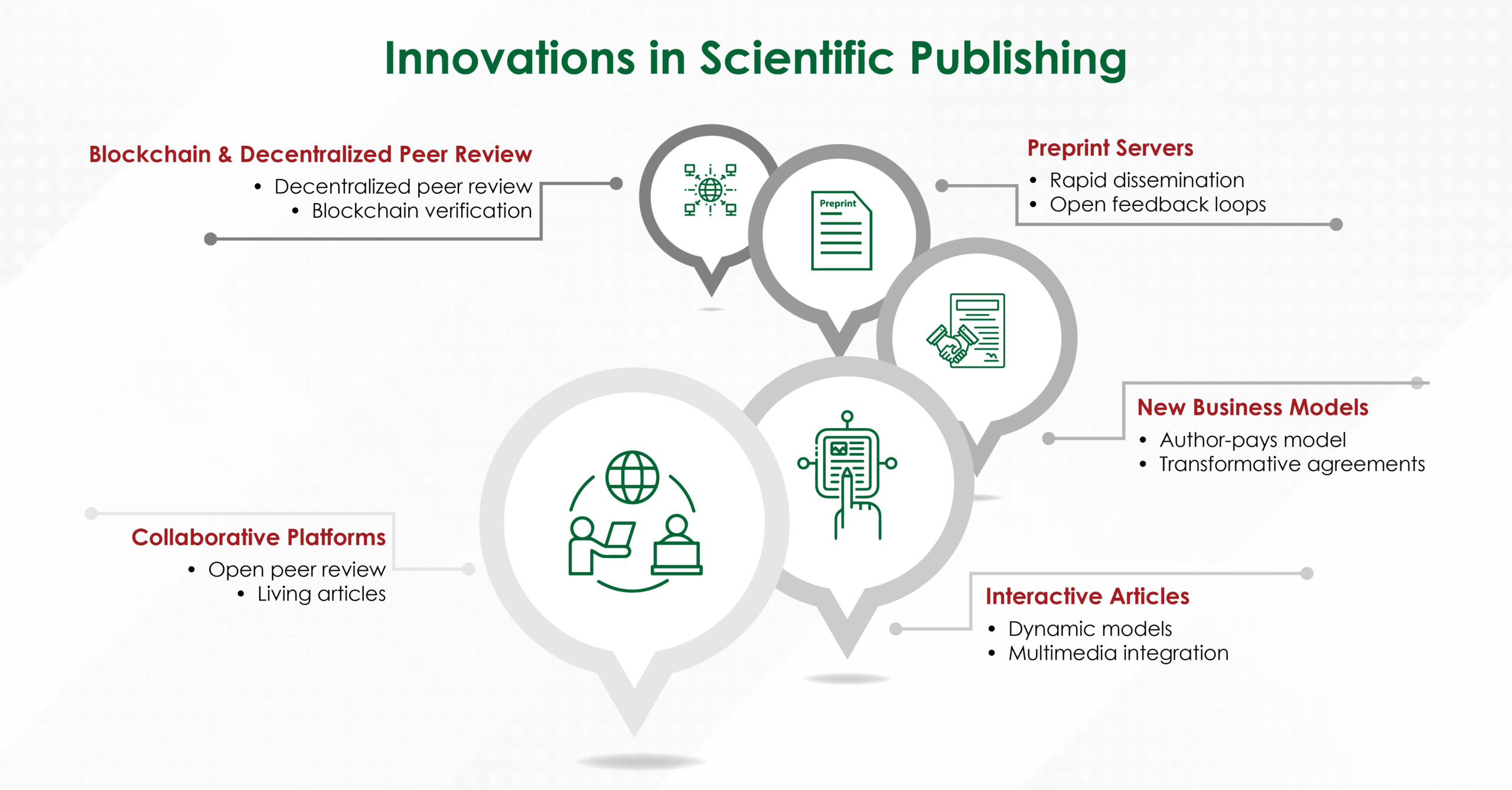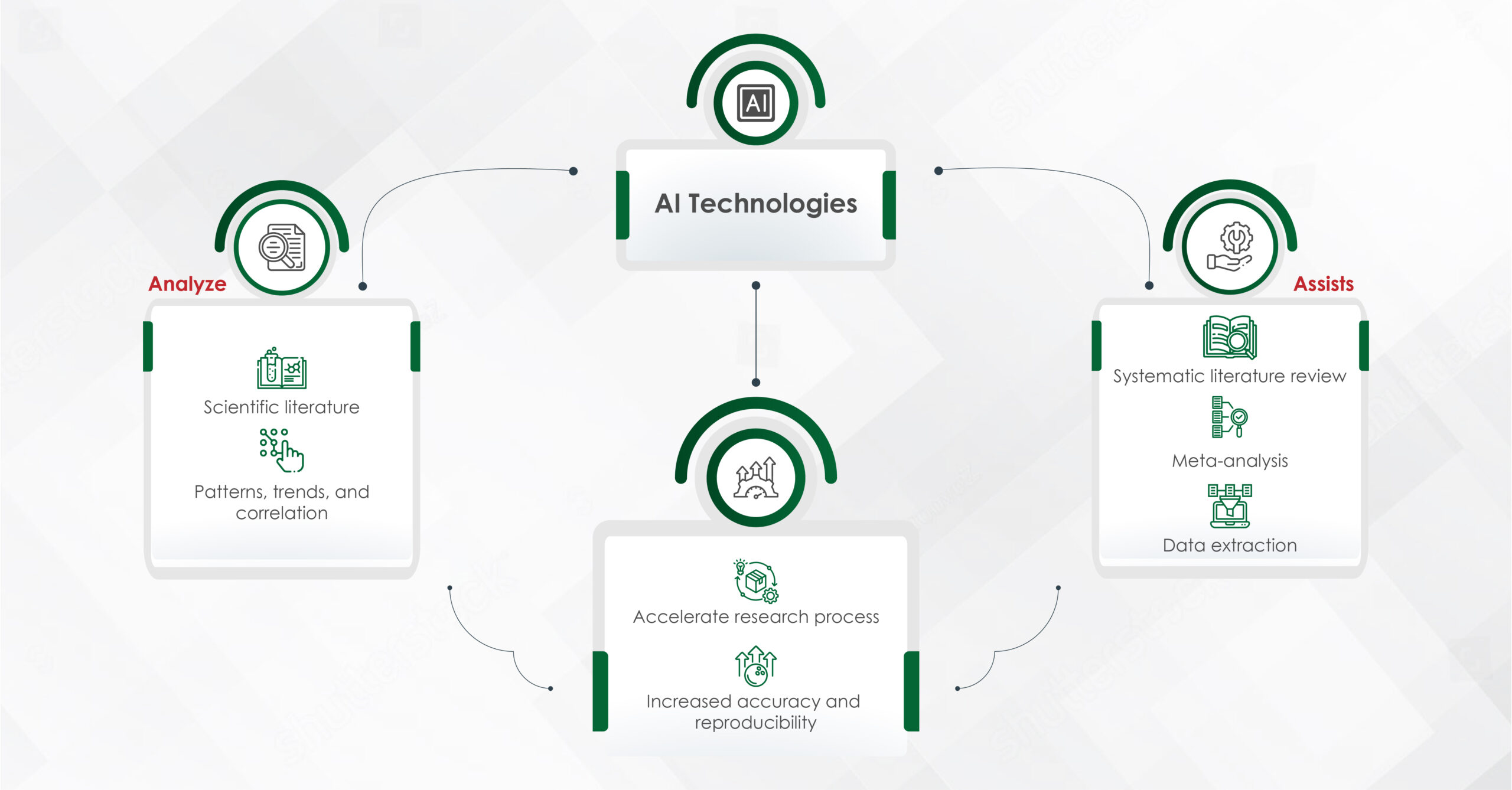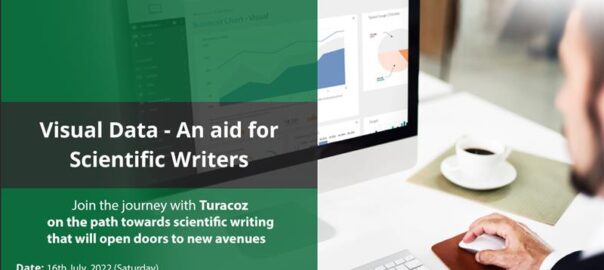The landscape of scientific publishing is transforming, driven by advances in technology, changes in business models, and the evolving needs of researchers, readers, and institutions. Traditional models, where scientific discoveries are disseminated in print journals, are being augmented—and in some cases, replaced by innovative practices that promise to make research more accessible, transparent, and interactive.
In this blog, we will explore key innovations in scientific publishing using real-world case studies to highlight how these changes have an impact. The focus is on collaborative platforms, interactive articles, and new business models that aim to address the limitations of traditional publishing.
- Collaborative Platforms: A New Era of Open Science
Collaborative platforms are transforming how research is conducted, shared, and evaluated. These platforms promote transparency and inclusivity, allowing scientists from around the globe to collaborate in real-time, access data more freely, and engage in open peer review. One example is F1000Research, a platform that has redefined how the scientific community shares and evaluates research.
Case Study: F1000Research
F1000Research is an open-access publishing platform in which researchers can submit their findings, datasets, and methods directly for immediate publication. What sets F1000Research apart from traditional journals is its approach to peer review. Instead of the pre-publication peer review process typically followed by academic journals, F1000Research employs post-publication peer review. This means that research is made available to the public and the scientific community without delays, and experts can assess and provide feedback on the content post-publication.
This model not only speeds up the dissemination of research but also fosters more open and constructive dialogue between authors and reviewers. Readers also benefit from having access to research as soon as it is submitted, which is especially valuable in fast-moving fields such as health and technology.
F1000Research also integrates collaborative features by allowing the inclusion of living articles that can be updated as new data emerges. This shifts the paradigm from static publications to dynamic, evolving pieces of scholarship.
Key Innovation
- Open peer review: Promotes transparency and constructive feedback.
- Living articles: Enable continuous updates and revisions aligned with the ever-evolving nature of scientific research.
- Interactive Articles: Enhancing Reader Engagement
The traditional static nature of scientific articles often limits their ability to communicate complex data effectively. With the advent of interactive articles, readers are now able to engage with research in meaningful and insightful ways. These articles often include dynamic elements such as embedded videos, datasets, or 3D models, enabling readers to explore findings in real time rather than just passively reading.
Case Study: The Elsevier Interactive Article
Elsevier, one of the largest academic publishers in the world, pioneered the development of interactive articles, particularly in fields that require complex data visualization, such as chemistry and biology. In collaboration with researchers, Elsevier created digital articles that allowed readers to explore datasets, simulations, and even molecular structures directly within the article.
For example, in a study on protein structures, the article allowed users to rotate 3D molecular models and explore different configurations of protein-binding sites. This interactive feature made it easier for readers to grasp the complexities of protein dynamics, something that would be difficult to understand through static images alone.
Moreover, interactive figures allow users to manipulate variables in datasets and immediately observe how changes affect the outcomes. This not only makes the research more engaging but also empowers readers to experiment with data and draw their conclusions.
Key Innovation
- Interactive figures and models: Enhance comprehension and engagement by allowing real-time manipulation of data.
- Multimedia integration: Incorporates video, audio, and 3D elements to enrich the reader’s experience and improve understanding.
- New Business Models: Breaking the Paywall
Traditional scientific publishing has long relied on subscription-based models, often limiting access to research on paywalls. However, a growing push towards open access has led to the development of new business models aimed at making research freely available to all. The transition to open access has been facilitated by initiatives such as Plan S and the rise of transformative agreements between universities and publishers.
Case Study: Plan S and PLOS ONE
Plan S, launched by a consortium of research funders in Europe, mandates that publicly funded research be published in open-access journals or platforms. This initiative has prompted a wave of changes in how scientific publishing operates, particularly by incentivizing publishers to transition from subscription models to fully open-access or hybrid models.
A successful example of open-access publishing is PLOS ONE, a multidisciplinary, open-access journal. PLOS ONE has gained prominence by charging authors a publication fee while making the research freely available to anyone. This model flips the traditional subscription-based revenue stream, making the cost borne by the authors rather than the readers or institutions.
The benefits of open access are clear: it allows for wider dissemination of knowledge, ensuring that research is not confined to those with access to expensive journal subscriptions. However, the model has also faced criticism for shifting the financial burden to researchers, particularly to those without sufficient funding. To address this, transformative agreements are emerging, in which institutions negotiate deals with publishers to cover open-access publication fees for their researchers.
Key Innovation
- Author-pays model: Shifts financial responsibility from readers to researchers, facilitating open access.
- Transformative agreements: Help institutions and publishers transition to open-access models while minimizing financial barriers.
- Preprint Servers: Speeding Up Knowledge Sharing
The preprint movement is another innovation that has gained momentum, particularly during the COVID-19 pandemic, when the rapid dissemination of research is crucial. Preprint servers allow researchers to share their findings before formal peer review, providing the global scientific community with access to cutting-edge research.
Read More: Strategies for Streamlining Scientific Publishing Services
Case Study: arXiv and bioRxiv
arXiv, launched in 1991, is one of the oldest and most widely used preprint servers, specializing in fields such as physics, computer science, and mathematics. Its success inspired the creation of bioRxiv, which serves the life science community. During the pandemic, bioRxiv saw an unprecedented surge in submissions, as researchers sought to rapidly share their findings with the world.
The preprint model allows for the fast dissemination of research, enabling real-time feedback and collaboration. However, this also raises concerns about the reliability of unreviewed findings, particularly when preprints are picked up by the media. However, preprint servers have become an integral part of the scientific publishing ecosystem, offering a balance between speed and rigorous peer review.
Key Innovation
- Rapid dissemination: Researchers can share their findings immediately, thereby accelerating knowledge transfer.
- Open feedback loops: Encourages early collaboration and feedback from the scientific community.
- Blockchain and Decentralized Peer Review: Ensuring Integrity

Blockchain technology is emerging as a tool to improve transparency and accountability in scientific publishing. By creating a decentralized system for tracking and verifying research, blockchain can help combat issues like plagiarism, data manipulation, and reviewer bias.
Case Study: ARTiFACTS
ARTiFACTS is a blockchain-based platform designed to improve the integrity of the research process. By recording each step of the research lifecycle, from data collection to peer review, on a blockchain, ARTiFACTS ensures that the research is transparent and traceable. This allows researchers to claim authorship over their work more securely and provides a verifiable chain of contributions.
Blockchain-based peer review is another innovation area. By decentralizing the peer review process, blockchain can make it more transparent, reduce the risk of bias, and increase trust in the system.
Key Innovation
- Decentralized peer review: Enhances transparency and accountability in the peer review process.
- Blockchain verification: Provides an immutable record of research activities, ensuring the integrity of the scientific process.
Conclusion
The innovations highlighted in this blog—collaborative platforms, interactive articles, open-access models, preprint servers, and blockchain technology—reshape the scientific publishing landscape. Enhancing transparency, improving accessibility, and fostering collaboration, these innovations promise to address some of the long-standing challenges in academic publishing.
At Turacoz, we are at the forefront of embracing these innovative trends in scientific publishing. Our team of experienced professionals is well-versed in leveraging collaborative platforms, creating interactive articles, and navigating new open-access models to enhance the impact and reach of your research. We understand the importance of rapid dissemination through preprint servers and the potential of blockchain technology to ensure research integrity. By choosing Turacoz, you gain a partner who can help you navigate this evolving landscape, ensuring your work benefits from the latest advancements in scientific communication while maintaining the highest standard of quality and ethics. Whether you need assistance with open peer review processes, creating dynamic content for interactive articles, or strategizing for open-access publication, we are here to support your academic publishing journey. Visit www.turacoz.com or contact us at [email protected] to discover how we can help elevate your research in today’s innovative publishing environment.





